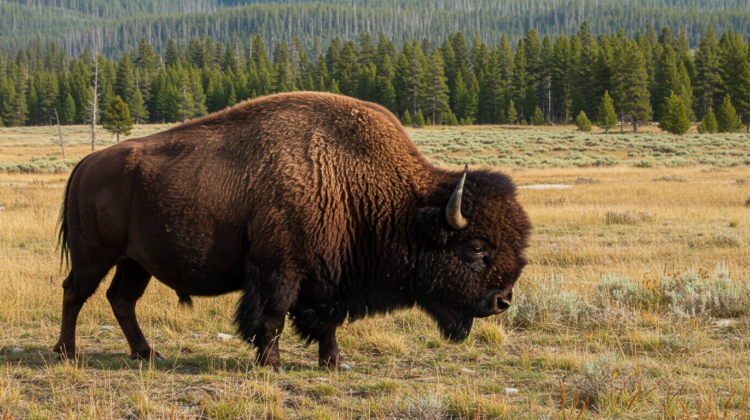
The stunning Yellowstone National Park is home to one of America’s most iconic wildlife species—the bison. However, this majestic herd has found itself at the center of a heated legal dispute. As the bison population in Yellowstone continues to grow, tensions are escalating between the state of Montana and the park’s management. The heart of the conflict? Montana filed a lawsuit over the management of the bison herd. Let’s break down the lawsuit, explore its implications, and answer some frequently asked questions.Yellowstone Bison Herd Lawsuit
What’s at the Core of the Yellowstone Bison Herd Lawsuit?
The dispute centers around the plan to manage Yellowstone’s bison population, which has been steadily increasing. The herd currently stands at around 5,400 bison. The plan, put forward by Yellowstone’s management, proposes a reduction of the bison population to about 3,000 to maintain ecological balance in the park.
Montana, however, is not happy with this plan. The state argues that the reduction could be harmful and believes the park’s management has excluded Montana from key decision-making processes. The state is particularly concerned about the potential risk of the bison spreading brucellosis, a bacterial disease that can be transmitted to cattle and other livestock.
So, why does this matter so much? The bison are more than just an iconic species—they have a vital role in Yellowstone’s ecosystem. On the other hand, concerns about livestock health are no small matter either. Montana is calling for more control over the management of the bison herd, and that’s where the lawsuit comes into play.
Choosing the Best Approach for the Yellowstone Bison Herd Lawsuit
When it comes to choosing the best strategy for handling the Yellowstone bison herd, there’s no one-size-fits-all solution. The best approach to resolving this issue lies in a balanced compromise—one that considers both environmental conservation and the concerns of the local agricultural community.
A careful and scientifically-based bison management plan should focus on:
- Ecological Impact: Ensuring the bison population does not negatively affect the park’s flora and fauna.
- Brucellosis Management: Balancing the protection of livestock with the preservation of wildlife.
- Collaborative Decision-Making: Involving local stakeholders, including Montana, in future decisions regarding the bison.
The lawsuit has brought these issues into the spotlight, encouraging a more thoughtful dialogue on how the bison should be managed.
The Best Line for Managing the Yellowstone Bison Herd
The best line, when it comes to managing the Yellowstone bison herd, would be one that finds common ground. Conservation is crucial, but so is the livelihood of ranchers in the surrounding areas. A solution that addresses both sides, such as a sustainable reduction in the herd size while taking measures to prevent the spread of brucellosis, might be the answer.
Collaboration among the state, park officials, environmentalists, and ranchers is necessary to avoid further conflict. This legal battle serves as a reminder that wildlife management isn’t just about preserving the animals—it’s also about protecting the interests of the community.
Read More: How Much Are Skunks as Pets
Valuable Tips for Navigating the Yellowstone Bison Herd Lawsuit
If you’re following this case or dealing with similar issues, here are a few valuable tips to consider:
- Stay Informed: Follow the lawsuit updates closely. The court’s decision could affect both local wildlife management and agricultural practices.
- Support Science-Based Solutions: Encourage decisions backed by scientific research to ensure that both wildlife and livestock are adequately protected.
- Engage with Stakeholders: It’s essential for all parties, from government agencies to local communities, to have a voice in the decision-making process.
- Advocate for Collaboration: The key to resolving conflicts like this one is finding common ground through collaboration, not confrontation.
FAQs About the Yellowstone Bison Herd Lawsuit
Q1: Why is the state of Montana suing Yellowstone National Park?
The state is suing over the park’s proposed plan to reduce the bison population. Montana argues that the plan could negatively impact livestock and that the park has not fully involved the state in the decision-making process.
Q2: What is brucellosis, and why is it a concern?
Brucellosis is a bacterial disease that can be transmitted from bison to cattle, resulting in reproductive issues and significant economic losses for ranchers. This is one of the main concerns behind Montana’s lawsuit.
Q3: What could happen if the lawsuit succeeds?
If Montana wins the lawsuit, it could lead to a change in the management plan, potentially allowing for greater state involvement in decisions related to the bison herd.
Q4: How does the bison population affect Yellowstone’s ecosystem?
A large bison population can have a significant impact on the park’s vegetation and other species. Maintaining a balanced population is crucial for preserving the ecosystem’s health.
Conclusion
The Yellowstone bison herd lawsuit is more than just a legal battle—it’s a reflection of the broader challenges faced when balancing wildlife conservation with the needs of local communities. As the case progresses, all parties must collaborate to find a solution that respects both the environment and the livelihoods of those who depend on it. After all, the fate of the Yellowstone bison is tied not only to the park’s ecological health but also to the people who live near it.
So, while the legal landscape is complex, the solution might just lie in finding a harmonious balance between preserving wildlife and protecting agriculture. Only time will tell how this will play out—but for now, it’s a fight worth watching closely.
See more amazing Information, Sweetpea Dog Puppy Bowl

Leave a Reply